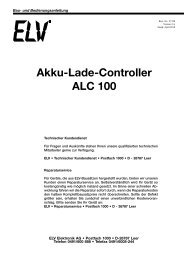Akku-Lade-Center Battery Charging Centre ALC 8500-2 ... - Batimex
Akku-Lade-Center Battery Charging Centre ALC 8500-2 ... - Batimex
Akku-Lade-Center Battery Charging Centre ALC 8500-2 ... - Batimex
Erfolgreiche ePaper selbst erstellen
Machen Sie aus Ihren PDF Publikationen ein blätterbares Flipbook mit unserer einzigartigen Google optimierten e-Paper Software.
4 Charge processes, charge outputs<br />
During the charge process the micro-controller constantly monitors the course of the voltage at each<br />
charge output individually. A series of successive measured values is used to assess the charge<br />
curve. For best possible results from the charge process the <strong>ALC</strong> <strong>8500</strong>-2 Expert constantly monitors<br />
the charge curve for the appropriate battery type with 14-bit accuracy.<br />
Reliable detection of the optimum charge cut-off point is particularly important. With NC and NiMH batteries<br />
the charger employs the reliable method of negative voltage difference (peak cut-off) at the end of the<br />
charge curve. Charge currents greater than 0.5 C are recommended, as they generate a pronounced Delta-<br />
V which the charger detects easily. If the unit registers a voltage difference of a few mV in the downward<br />
direction over several measurement cycles at the battery, that channel switches to a trickle charge rate.<br />
The same applies to NiMH batteries, except that the charge curve is shallower than that of NC batteries,<br />
and the charger takes this into account. In the case of Lead-acid, Lithium-ion and Lithium-polymer<br />
batteries the charge cut-off point is detected according to the current / voltage curve.<br />
Transfer resistances at the terminal clamps can have an adverse effect on the accuracy of the measurement,<br />
and for this reason the battery voltage of NC and NiMH batteries is always measured under<br />
zero-current conditions. Batteries which have been stored or deep-discharged tend to provoke premature<br />
charge termination, but the <strong>ALC</strong> <strong>8500</strong>-2 Expert features an additional pre-peak detection<br />
circuit which reliably prevents this occurring.<br />
Where batteries are in a deep-discharged state, the <strong>ALC</strong> <strong>8500</strong>-2 Expert delivers an initial pre-charge<br />
at a reduced current.<br />
Most high-capacity nickel-metal-hydride batteries are very sensitive to overcharging, but this drawback<br />
is balanced by their immunity to the memory effect, which is a common problem with NC batteries.<br />
Long intervals between periods of use, followed directly by recharging (i.e. without first discharging)<br />
are one cause of the memory effect with NC cells; another is constant partial discharges followed by<br />
topping-up. The electrolyte then tends to crystallise out at the electrodes, thereby obstructing the flow<br />
of electrons within the cell. A series of discharge / charge cycles often has the effect of restoring the<br />
full capacity of such packs.<br />
Clearly a charger which only provides a simple charge function is not sufficient for optimum maintenance<br />
of any rechargeable battery. The <strong>ALC</strong> <strong>8500</strong>-2 Expert offers various programs for comprehensive<br />
battery maintenance, all aimed at maximising useful battery life. As you would expect, all channels<br />
can be programmed to carry out different processes at the same time.<br />
To dissipate waste heat during discharge processes the <strong>ALC</strong> <strong>8500</strong>-2 Expert is equipped with an internal<br />
heat-sink / cooling fan assembly, and a temperature monitor operates constantly at the output<br />
stages to protect the charger from overloading in every situation.<br />
Charge channels 1 and 2 are designed for a charge voltage up to 30 V (corresponding to a nominal<br />
battery voltage of 24 V with NC and NiMH) and maximum output currents of up to 5 A.<br />
The output currents available vary according to the cell count of the connected battery, as they are<br />
limited by the available charge power.<br />
The maximum total charge power for channels 1 and 2 is 40 VA. Please note that the basis for calculating<br />
this figure is not the nominal battery voltage; a higher voltage must be taken into account under<br />
charging conditions. For example, if an output power of 30 VA is drawn for channel 1, the 10 VA is still<br />
available for channel 2. As long as the total power remains below 40 VA, both channels operate simultaneously.<br />
If this is not the case, the channel whose process was started last has to wait until the<br />
required power is available, i.e. when the charge process of the channel first started is concluded; the<br />
second process then starts automatically.<br />
Charge outputs 3 and 4 are designed to operate at a maximum output voltage of 15 V, corresponding<br />
to a nominal battery voltage of 12 V with NC and NiMH batteries. In this case the maximum possible<br />
charge current is 1 A, shared by the two outputs working simultaneously. For example, if a charge<br />
current of 500 mA is selected for channel 3, then 500 mA is also available for channel 4. However,<br />
channel 4 can supply 800 mA if channel 3 is only delivering 200 mA.<br />
37



